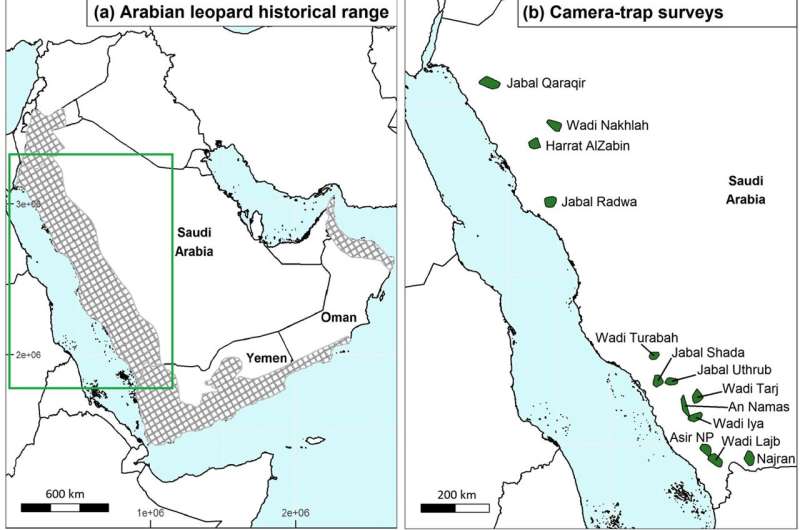This article has been reviewed according to Science X's editorial process and policies. Editors have highlighted the following attributes while ensuring the content's credibility:
fact-checked
peer-reviewed publication
trusted source
proofread
Researchers find no evidence of Arabian leopards despite extensive search in Saudi Arabia

Researchers have concluded that Saudi Arabia is likely no longer home to sustainable populations of Arabian leopards, as detailed in the journal Oryx.
Panthera, the global wild cat conservation organization, alongside the Royal Commission for AlUla, spent two years surveying their historical range to find any signs that Arabian leopards remain, but with no luck.
These findings indicate it is likely that leopard populations will not recover in Saudi Arabia without human-designed breeding programs and reintroductions of captive-bred leopards into the wild. This holds true regardless of whether leopards have become completely extinct or reduced to a small number of isolated individuals.
This research is of landmark significance to the ongoing study of Arabian leopards. They are categorized as Critically Endangered on the IUCN Red List, with an estimated population of fewer than 200 individuals remaining in their natural habitat. Historically, their largest population thrived in Saudi Arabia; however, the absence of confirmed sightings since 2014 has underscored the urgency of ascertaining their current presence and distribution to aid in the planning of conservation efforts.
In working to detect any remaining Arabian leopard populations in Saudi Arabia, the researchers conducted 14 comprehensive surveys, spanning over 4,000 km2 of historical leopard habitat and resulting in a cumulative effort of over 80,000 camera-trap nights.
Concurrently, questionnaires were conducted with 843 members of local communities in relevant areas to assess the presence of leopards, other predators and prey species. Predator scats were also collected ad hoc by field teams for mitochondrial DNA analysis for species identification.
Over 60,000 independent captures of animals or people were obtained by the camera traps, but none were of Arabian leopards. Local people reported three sightings of leopards in the last year, but targeted camera surveys found no evidence of leopards in these areas. Similarly, no leopard DNA was identified from scats.
The conclusion is that there are probably no sustainable populations of Arabian leopards in Saudi Arabia, although the researchers cannot rule out that a few isolated individuals may still be surviving in the most remote mountains.
The historic decline in leopard numbers in Saudi Arabia can be attributed to a variety of environmental and anthropogenic factors. These include direct threats such as hunting and trapping for the illegal wildlife trade as well as declines in prey numbers, and indirect threats such as increasing urbanization, road construction and mining that cause habitat degradation.
C. E. Dunford, the primary author of the research paper, emphasized the constructive nature of these research findings.
"Our comprehensive survey did not detect any conclusive evidence of Arabian leopards living in the areas surveyed. However, this should not be interpreted as a final blow for the Arabian leopard, Critically Endangered though they are," said Dunford.
"Rather, now we are equipped with this knowledge, it will be possible for conservationists and policymakers to respond more effectively to the actual state of the Arabian leopard today. We now know exactly how endangered they are; consequently, we can take targeted steps to reintroduce them into the wild and ensure they have sufficiently sustainable habitats to prosper."
More information: Carolyn E. Dunford et al, Searching for spots: a comprehensive survey for the Arabian leopard Panthera pardus nimr in Saudi Arabia, Oryx (2023). DOI: 10.1017/S0030605323000807
Journal information: Oryx
Provided by Cambridge University Press


















